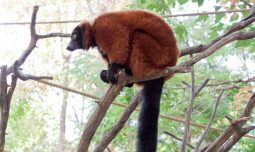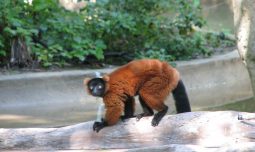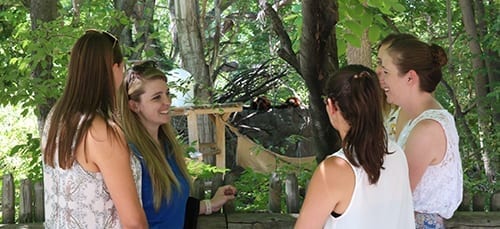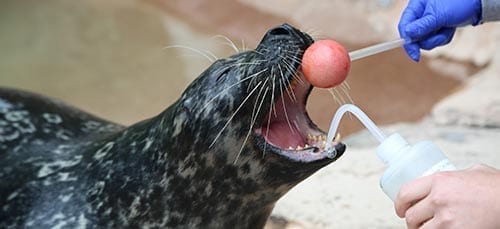Classification
Class Mammalia
Order Primate
Family Lemuridae
Genus Varecia
Species rubra
Habitat & Range
Red ruffed lemurs live primarily in the top canopy of the tropical, lowland forests of the Masoala Peninsula including the Masoala National Park.

Red-ruffed Lemur
Variegata rubra
Red ruffed lemurs are diurnal (active during the day), usually foraging in groups. Social organization varies depending on season and habitat quality. In some areas, groups are small with two to five individuals and in other areas or when fruit is plentiful, larger loose affiliations are formed of up to 32 individuals.
Adaptations
- Quadrupedal and mostly arboreal, moving in the trees, but will occasionally walk on the ground. Movement in trees is by leaping, clinging, and suspending by back feet.
- Six bottom teeth known as a tooth comb and a long claw on the second toe are used for grooming long, thick fur.
- A long muzzle allows for collecting pollen from flowers without harming the flower.
- Large range of 12 vocalizations aids in communication.
- Thick bushy tail serves as a visual signal when threatened and as a balancing tool.
- Soft, broad fingers with flat nails aid in grasping and grooming.
Physical Description
- Red ruffed lemurs are 15-18 inches (39-46 cm) long with a 22-25 inch (56-63 cm) tail.
- They weigh five to seven and a half pounds (2.3. – 3.5 kg)
- They have dense gray fur with white undersides. The face is white with dark triangular eye patches and a black pointed muzzle.
- Their distinctive tails are black and white striped.
Diet
What Does It Eat?
In their historic range:
Red ruffed lemurs are mostly frugivores in the wild consuming fruit, nectar and pollen, but also leaves, seeds and flowers.
At the zoo:
Variety of vegetables, greens, starches, and low-starch biscuits. Small amounts of fruit for training purposes.
What Eats It?
Wild predators of red ruffed lemurs are boa constrictors, eagles, hawks, and fossa (a weasel-like animal). Humans also hunt and trap lemurs for food and the pet trade.
Social Organization
Social organization varies depending on season and habitat quality. In some areas, groups are small with two to five individuals and in other areas or when fruit is plentiful, larger loose affiliations are formed of up to 32 individuals. Established territories are defended against other groups. Males and females form separate overlapping ranges. Loud, raucous, barking vocalizations allow group members to stay in contact, and serve as warning to intruders and warn of the presence of predators. Scent marking is another means of communicating and defending territory. Females are the central force in groups and dominant to males. Lemurs groom each other for hygiene and to cement social bonds.
Life Cycle
These prosimians (primates evolving before monkeys and apes) have a life span in the wild of 15 to 20 years but can live more than 30 years in human care. Red ruffed lemurs are polygamous, and breeding is seasonal in the wild between May and July. Ruffed lemurs are one of only a few primates that have litters. Litter size is typically two to three but can be up to six, and mothers can nurse six simultaneously. Typical gestation is 100 days. Births take place in well-concealed tree nests, unusual for diurnal primates. Young are removed from the nest after a week or two. Mothers will carry each in her mouth rather than on her back like other lemur species. Weaning occurs at about 4 months and sexual maturity at about two years. Males will protect young.
Collection Connection
- Mego was born 4/20/04. Mego can be easily recognized by the white ring around the base of his tail. He enjoys sleeping in the sun and showing off his “hanging” behavior (behavior you would see in the wild). Mego is Penny’s father and came to the Zoo in 2014 from The Duke Lemur Center in North Carolina.
- Sixpence was born 6/3/98. Sixpence enjoys sleeping under heat lamps and trying to find alone time away from her daughter Penny. Sixpence was born at the Zoo.
- Penny was born 4/25/17. Penny is very active and enjoys jumping on her parents to get them to play. She also loves interacting with various enrichment items by jumping on them and in them (i.e. blankets, trash cans, hanging tubs).
Conservation Status
IUCN Status: Critically Endangered
Declines in both habitat area and quality continue due to human encroachment and an upsurge of illegal logging since 2009. Frequent cyclones (hurricanes) also contribute to significant declines because of the concentration and severe fragmentation of remaining populations.

Download the App!
Get the FREE Denver Zoo app today, and be a pro the next time you visit the Zoo. You’ll get access to the Zoo map, daily activities and schedules, animal facts, and more. You can even load your membership card onto the app for additional convenience. It puts everything you need for an amazing Zoo experience right into the palm of your hand!





